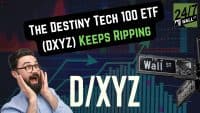
Volatility has risen in recent weeks, especially after the Fed meeting and Fitch downgrade of U.S. credit rating, putting a pause in the rally of U.S. stocks. The Nasdaq Composite and S&P 500 Index declined 2.9% and 2.3%, respectively, marking their worst weeks since March, while the Dow Jones declined 1.1%.
Inside The Decline
The Fed, in its latest meeting, raised interest rates by a quarter-percentage point to 5.25-5.50%, the highest level since March 2001, marking the 11th rate increase. The central bank also signaled the possibility of further increases ahead.
“Recent indicators suggest that economic activity has been expanding at a moderate pace,” the Fed said in its statement. “Job gains have been robust in recent months, and the unemployment rate has remained low. Inflation remains elevated.” Although inflation has dropped from the peak of 9.1%, it has a long way to go to meet the Federal Reserve’s 2% target. The increase in interest rates has made borrowing expensive, pushed up the cost of buying a new car or house, increased the cost of carrying credit card debt and thus slowed down economic growth.
Meanwhile, Fitch Ratings downgraded the U.S. credit rating to AA+ from AAA, citing “expected fiscal deterioration over the next three years,” an erosion of governance and a growing general debt burden. This has led to strong sell-off in the stocks and a surge in yields. Notably, Treasury yields spiked to the highs of 2023 last week. The 10-year yields topped 4.12%, marking the highest level since November 2022, while 30-year yields reached their highest level in nearly nine months to about 4.2%. The plans of a flood of government-debt issuance and signs of the labor market’s enduring strength also pushed the yields higher.
target= “_blank” In such a scenario, investors are seeking exposure to alternative sources of income rather than equity and bonds. For these investors, an allocation to low-beta ETFs like Core Alternative ETF CCOR, Innovator Defined Wealth Shield ETF BALT, AdvisorShares Let Bob AI Powered Momentum ETF LETB, Invesco S&P 500 Downside Hedged ETF PHDG, and Global X Nasdaq 100 Risk Managed Income ETF QRMI could be the safest, for as long as the uncertainty lingers.
Why Low Beta?
Beta measures the price volatility of stocks or funds relative to the overall market. It has a direct relationship to market movements. A beta of 1 indicates that the price of the stock or fund tends to move with the broader market. A beta of more than 1 indicates that the price tends to move higher than the broader market and is extremely volatile, while a beta of less than 1 indicates that the price of the stock or fund is less volatile than the market.
Investing in low-beta stocks during times of market volatility can offer several advantages:
Reduced Volatility: Low-beta stocks tend to have lower price fluctuations, making them more stable investments during turbulent market conditions.
Defensive Characteristics: Low-beta stocks are often found in defensive sectors like utilities, healthcare and consumer staples. These industries tend to perform relatively well during economic downturns, as their products and services are still in demand.
Dividend Income: Low-beta stocks are often associated with established, mature companies that pay regular dividends. Dividend income can provide a steady cash flow to investors and help offset potential declines in the stock’s price.
Capital Preservation: By investing in low-beta stocks, investors can aim to preserve their capital during market downturns due to reduced volatility associated with these investments.
Diversification: Including low-beta stocks in a diversified portfolio can help balance out riskier, high-beta investments, potentially improving the overall risk-adjusted return of the portfolio.
That said, low-beta ETFs exhibit greater levels of stability than their market-sensitive counterparts and will usually lose less when the market is crumbling. Though these have lesser risks and lower returns, the funds are considered safe and resilient amid uncertainty.
However, when markets soar, these low-beta funds experience lesser gains than the broader market counterparts and thus lag their peers.
ETFs in Focus
Core Alternative ETF (CCOR): Beta – 0.09
The Core Alternative ETF is an actively managed ETF, which aims to preserve potential long-term growth with “responsive” downside risk mitigation. It invests in U.S. large-cap stocks and actively balances the downside risk with a highly disciplined “protective-put” options strategy. The Core Alternative ETF holds 45 securities in its basket and charges a high expense ratio of 1.07%.
CCOR has amassed $402.4 million in its asset base and trades in a lower volume of 72,000 shares.
Innovator Defined Wealth Shield ETF (BALT): Beta – 0.10
Innovator Defined Wealth Shield ETF seeks to track the return of the SPDR S&P 500 ETF Trust SPY, to a cap, and provide a measure of downside protection by seeking to buffer investors against losses. The ETF targets a 20% buffer every 3-month outcome period.
Innovator Defined Wealth Shield ETF has AUM of $418.8 million and trades in average daily volume of 123,000 shares. It charges 69 bps in annual fees.
AdvisorShares Let Bob AI Powered Momentum ETF (LETB): Beta – 0.11
AdvisorShares Let Bob AI Powered Momentum ETF is an actively managed ETF that incorporates technology, automation and access to unique data into its investment strategy to analyze a blend of fundamental data, including companies expected to exceed earnings estimates, digital sentiment, and strong technical price momentum. This results in a portfolio of select stocks the advisor believes will outperform. LETB can lower equity exposure depending on the market condition or move to cash for additional risk management in downward-trending markets.
AdvisorShares Let Bob AI Powered Momentum ETF has accumulated $24.3 million in its asset base and charges 1.07% in fees. It trades in an average daily volume of 6,000 shares.
Invesco S&P 500 Downside Hedged ETF (PHDG): Beta – 0.36
Invesco S&P 500 Downside Hedged ETF is an actively managed fund and seeks to deliver positive returns in rising or falling markets that are not directly correlated to broad equity or fixed-income market returns. Invesco S&P 500 Downside Hedged ETF tries to follow the S&P 500 Dynamic VEQTOR Index, which provides broad equity market exposure with an implied volatility hedge by dynamically allocating between different asset classes: equity, volatility and cash. The index allows investors to receive exposure to the equity and volatility of the S&P 500 Index in a dynamic framework.
Invesco S&P 500 Downside Hedged ETF has AUM of $172.1 million and charges 39 bps in fees per year from its investors. Volume is lower, exchanging 38,000 shares a day on average.
Global X Nasdaq 100 Risk Managed Income ETF (QRMI): Beta – 0.39
Global X Nasdaq 100 Risk Managed Income ETF employs a protective net-credit collar strategy for investors seeking the income characteristics of a covered call fund, while mitigating the risks of a major market selloff with a protective put. QRMI seeks to achieve this outcome by owning the stocks in the Nasdaq 100 Index (NDX), while buying 5% out-of-the-money put options on NDX and selling at-the-money call options on the same index. Global X Nasdaq 100 Risk Managed Income ETF follows the Nasdaq-100 Monthly Net Credit Collar 95-100 Index and holds 105 securities in its basket.
Global X Nasdaq 100 Risk Managed Income ETF has gathered $10.9 million in its asset base and charges 60 bps in fees per year. The product trades in a lower average daily volume of 7,000 shares.
Bottom Line
Investors should note that these products are not meant to generate outsized returns. Instead, these provide stability in the portfolio, protecting the initial investment. In particular, these products could be worthwhile for low-risk-tolerant investors looking to safeguard their portfolio in a rocky market and some outperformance, especially if market uncertainty prevails in the coming months.
SPDR S&P 500 ETF (SPY): ETF Research Reports
Innovator Defined Wealth Shield ETF (BALT): ETF Research Reports
Invesco S&P 500 Downside Hedged ETF (PHDG): ETF Research Reports
Core Alternative ETF (CCOR): ETF Research Reports
Global X Nasdaq 100 Risk Managed Income ETF (QRMI): ETF Research Reports
AdvisorShares Let Bob AI Powered Momentum ETF (LETB): ETF Research Reports
To read this article on Zacks.com click here.
This article originally appeared on Zacks
Thank you for reading! Have some feedback for us?
Contact the 24/7 Wall St. editorial team.



